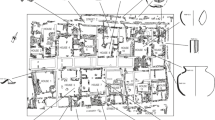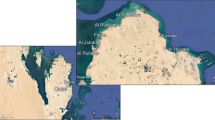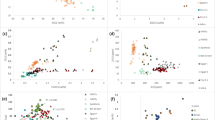Abstract
SEM-EDX quantitative analyses were performed on 91 samples of vessel glass originating from a number of sites throughout Tuscany. A comparison with Venetian glass data is made in order to evaluate differences in glassmaking materials. The compositions of the samples provide clues about the different raw materials used in relation to recipes that changed slightly during the period covering the late Middle Ages to early Renaissance. Two kinds of ash used as a fluxing agent were identified, one of which is of east Mediterranean origin while the other is likely to be Spanish. Two types of silica sources were also found. One of these was recognized as being quartziferous river pebbles, while the other is proposed to be local sand.




Similar content being viewed by others
References
Casellato U, Fenzi F, Guerriero P, Sitran S, Vigato PA, Russo U, Galgani M, Mendera M, Manasse A (2003) Medieval and renaissance glass technology in Valdelsa (Florence). Part 1: raw materials, sands and non vitreous finds. J Cult Herit 4:337–353
Bianchin S, Brianese N, Casellato U, Fenzi F, Guerriero P, Vigato PA, Nodari L, Russo U, Galgani M, Mendera M (2005) Medieval and renaissance glass technology in Valdelsa (Florence). Part 2: vitreous finds and sands. J Cult Herit 6:39–54
Bianchin S, Brianese N, Casellato U, Fenzi F, Guerriero P, Vigato PA, Battagliarin M, Nodari L, Russo U, Galgani M, Mendera M (2005) Medieval and renaissance glass technology in Valdelsa (Florence). Part 3: vitreous finds and crucibles. J Cult Herit 6:165–182
Brianese N, Casellato U, Fenzi F, Sitran S, Vigato PA, Mendera M (2005) Medieval and renaissance glass technology in Tuscany. Part 4: the XIVth sites of Santa Cristina (Gambassi-Firenze) and Poggio Imperiale (Siena). J Cult Herit 6:213–225
Verità M, Zecchin S (2007) Thousand years of Venetian glass: the evolution of chemical composition from the origins to the 18th century. In: Ann 17th AIHV Congr, Antwerp, Belgium, 4 Sept 2006
Frank S (1982) Glass and archaeology. Academic, London, pp 2–10
Fenzi F, Mendera M, Vigato PA (2007) Technology of Medieval and Renaissance glass in Tuscany (Italy): an interdisciplinary approach to the study of production indicators. In: Ann 17th AIHV Congr, Antwerp, Belgium, 4 Sept 2006
Galgani M, Mendera M (2001) Produzione e consumo del vetro medievale a San Gimignano: testimonianze archeologiche e storiche. In: Ferrari D (ed) Vetri di ogni tempo. Scoperte, Produzione, Commercio, Iconografia. Atti della V Giornata Nazionale di Studio, Massa Martana, Perugia, 30 Oct 1999, pp 87–100
Boldrini GE, Mendera M (1994) Consumo del vetro d’uso comune a San Giovanni Valdarno (AR) nel ‘500: caratteristiche tecnologiche e tipologiche. Archeol Mediev XXI:499–516
Univ Studi di Siena (2008) Portale di Archeologia medievale. http://www.paesaggimedievali.it/luoghi/CAMP/index.html. Accessed 11 Feb 2008
Reed SJB (1993) Electron microprobe analysis. Cambridge University Press, Cambridge
Schalm O (2000) Characterization of paint layers in stained glass windows. Ph.D. dissertation, University of Antwerp, pp 45–71
Schalm O, Janssens K (2003) A flexible and accurate quantification algorithm for electron probe x-ray microanalysis based on thin-film element yields. Spectrochim Acta B 58:669–680
Barrera J, Velde B (1989) A study of French medieval glass composition. Archéol Médiév XIX:81–130
Author information
Authors and Affiliations
Corresponding author
Rights and permissions
About this article
Cite this article
Cagno, S., Janssens, K. & Mendera, M. Compositional analysis of Tuscan glass samples: in search of raw material fingerprints. Anal Bioanal Chem 391, 1389–1395 (2008). https://doi.org/10.1007/s00216-008-1945-8
Received:
Revised:
Accepted:
Published:
Issue Date:
DOI: https://doi.org/10.1007/s00216-008-1945-8




